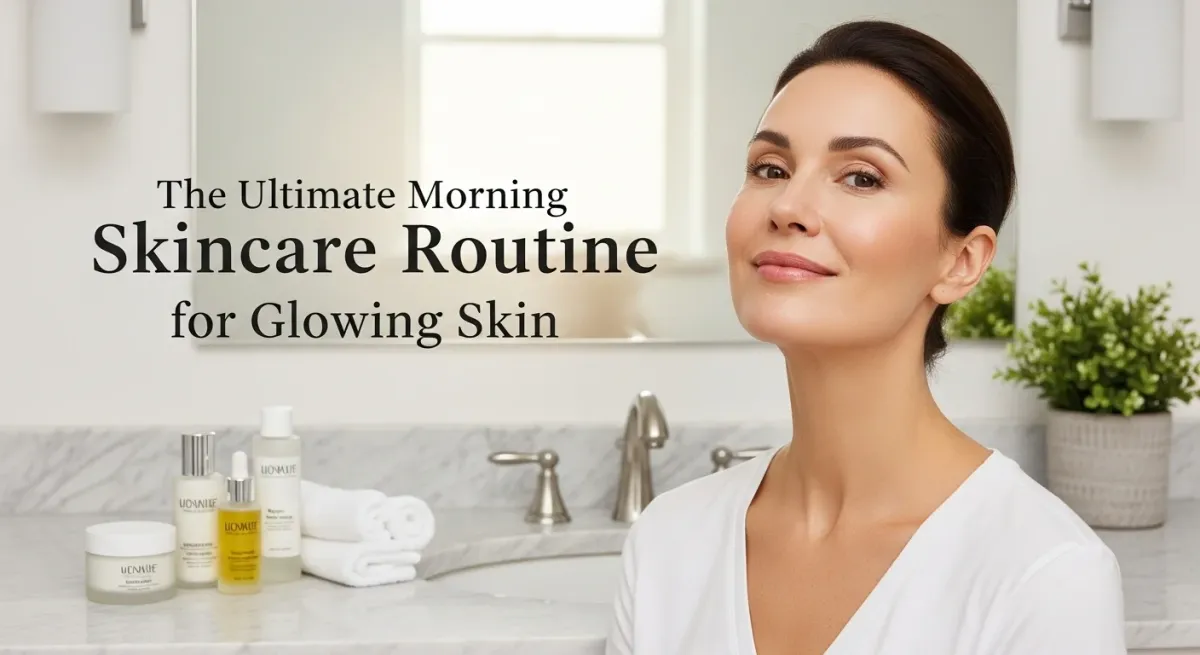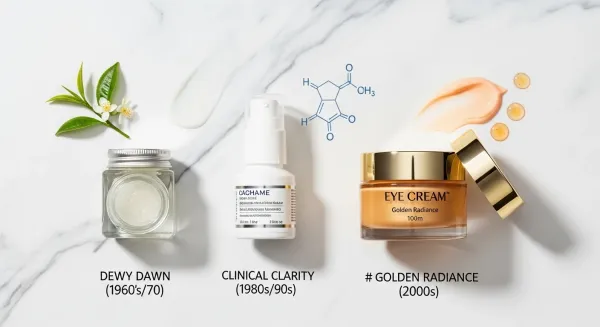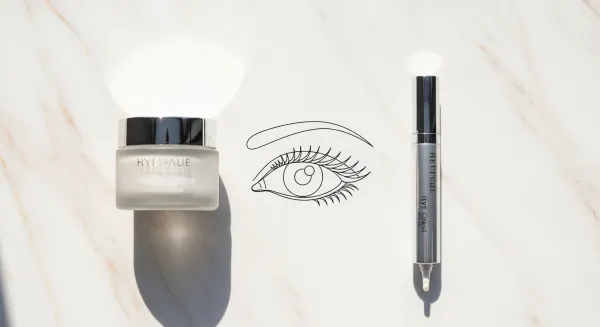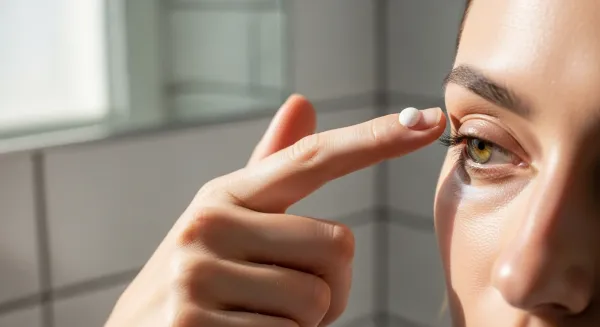The Ultimate Morning Skincare Routine for Glowing Skin
Discover the ultimate morning skincare routine for glowing skin with simple steps and essential tips!

A great morning skincare routine can make a big difference in how your skin looks and feels.
Starting your day with the right steps helps keep your skin healthy, glowing, and ready to face whatever comes your way.
Here’s a simple guide to creating the ultimate morning skincare routine that will leave you feeling fresh and radiant all day long.
Key Takeaways
- Use a gentle cleanser to wash away dirt and oil without drying out your skin.
- Exfoliate a few times a week to remove dead skin cells and reveal fresh skin underneath.
- Always apply sunscreen to protect your skin from harmful UV rays, even on cloudy days.
- Incorporate a hydrating serum to boost moisture and keep your skin plump.
- Finish with a facial mist for a refreshing touch throughout the day.
Start with a Gentle Cleanser

Why a Gentle Cleanser Matters
Starting our day with a gentle cleanser is super important. It helps remove dirt and oil that builds up overnight, leaving our skin fresh and ready for the day. Using a harsh cleanser can strip our skin of its natural oils, leading to dryness or irritation.
How to Choose the Right Cleanser
When picking a cleanser, we should consider our skin type. Here are some tips:
- Oily Skin: Look for gel-based cleansers that can help control oil.
- Dry Skin: Creamy cleansers are great for adding moisture.
- Sensitive Skin: Choose fragrance-free and hypoallergenic options.
Steps to Properly Cleanse Your Face
- Wet your face with lukewarm water.
- Apply a small amount of cleanser to your fingertips.
- Gently massage the cleanser onto your skin in circular motions for about 30 seconds.
- Rinse thoroughly with water and pat dry with a clean towel.
Remember, cleansing is the first step in our ultimate daily routine for combination skin. It sets the stage for all the other products we’ll use!
Exfoliate to Remove Dead Skin Cells
Benefits of Exfoliation
Exfoliating our skin is like giving it a fresh start! It helps remove dead skin cells, which can make our skin look dull. By getting rid of these cells, we can reveal the brighter, healthier skin underneath. Plus, exfoliation can help our other skincare products work better. Here are some benefits:
- Improves skin texture
- Unclogs pores
- Promotes cell turnover
Types of Exfoliants
When it comes to exfoliating, we have two main types to choose from:
- Physical Exfoliants: These are scrubs or tools that we can use to manually slough off dead skin. Think of sugar scrubs or exfoliating gloves.
- Chemical Exfoliants: These use acids or enzymes to dissolve dead skin cells. Common ingredients include glycolic acid and salicylic acid.
How Often Should You Exfoliate?
We should aim to exfoliate about 2-3 times a week. Overdoing it can lead to irritation, especially if we’re out in the sun a lot. Here’s a quick guide:
Skin Type | Recommended Frequency |
|---|---|
Oily | 2-3 times a week |
Dry | 1-2 times a week |
Sensitive | Once a week |
Remember, exfoliation is important, but moderation is key! Too much can harm our skin barrier and lead to more problems.
So, let’s make sure we’re exfoliating wisely to keep our skin glowing!
Apply a Refreshing Toner
What Does a Toner Do?
After we cleanse our faces, it’s time to bring back some balance and hydration with a refreshing toner. Toners help refine our pores and reduce inflammation, making our skin feel fresh and ready for the next steps. They’re like a quick drink of water for our skin!
Choosing the Best Toner for Your Skin Type
When picking a toner, we should consider our skin type. Here are some tips:
- For oily skin: Look for toners with salicylic acid to help control oil.
- For dry skin: Choose hydrating toners with glycerin or hyaluronic acid.
- For sensitive skin: Opt for alcohol-free toners with soothing ingredients like aloe vera.
How to Apply Toner Correctly
Applying toner is super easy! Here’s how we can do it:
- Remove makeup and surface debris.
- Wash your face to get rid of any leftover dirt.
- Choose your formula based on your skin type.
- Apply your toner using a cotton pad or your fingertips.
- Follow with serum to lock in that hydration.
Remember, using a toner is a great way to prep our skin for the day ahead! It’s a small step that makes a big difference in our skincare routine.
Use a Hydrating Serum

Why Hydration is Key
When it comes to achieving that glowing skin we all want, hydration is super important! A good hydrating serum can make a huge difference in how our skin looks and feels. It helps to keep our skin plump and youthful, reducing the appearance of fine lines and dryness.
Ingredients to Look for in a Serum
Not all serums are created equal, so here are some ingredients we should keep an eye out for:
- Hyaluronic Acid: This ingredient can hold up to 1,000 times its weight in water, making it a hydration powerhouse.
- Glycerin: A great humectant that draws moisture into the skin.
- Vitamin C: Not only hydrates but also brightens the skin and fights free radicals.
How to Apply Serum for Best Results
Applying serum correctly is key to getting the most out of it. Here’s how we can do it:
- Cleanse: Start with a clean face to allow the serum to penetrate better.
- Tone: Use a toner to prep the skin and enhance absorption.
- Apply Serum: Use a few drops and gently press it into the skin, focusing on areas that need extra hydration.
- Moisturize: Follow up with a moisturizer to lock in all that goodness.
Remember, consistency is key! Using a hydrating serum daily can help us maintain that dewy look we all love.
By incorporating a hydrating serum into our routine, we can tackle dryness and keep our skin looking fresh and vibrant. Plus, it’s a simple step that can really elevate our skincare game!
Don't Forget Eye Cream

Importance of Eye Cream
We all know that the skin around our eyes is super delicate. Using an eye cream can really help keep that area hydrated and reduce the appearance of fine lines. It’s like giving your eyes a little extra love!
How to Apply Eye Cream
Applying eye cream is easy! Here’s how we do it:
- Use your ring finger: It’s the gentlest finger, perfect for this sensitive area.
- Dab, don’t rub: Gently tap the cream around your eyes. No need to rub it in!
- Start from the inner corner: Work your way outwards for even coverage.
Best Ingredients for Eye Area
When picking an eye cream, look for these key ingredients:
- Hyaluronic Acid: For hydration.
- Caffeine: Helps reduce puffiness.
- Peptides: Great for boosting collagen.
Remember, taking care of our eyes is just as important as the rest of our skincare routine!
Moisturize to Lock in Hydration
Choosing the Right Moisturizer
When it comes to keeping our skin hydrated, moisturizing is a must. It helps to lock in moisture and creates a barrier against the elements. Here’s what we should consider:
- Skin Type: Whether we have oily, dry, or combination skin, there’s a moisturizer out there for us.
- Texture Preference: Some of us might prefer a lightweight gel, while others might go for a rich cream.
- Added Benefits: Look for moisturizers with SPF to protect our skin from sun damage throughout the day.
How to Apply Moisturizer Correctly
Applying moisturizer the right way can make a big difference. Here’s a simple guide:
- Start with Clean Skin: Always apply on freshly cleansed skin.
- Use the Right Amount: A pea-sized amount is usually enough for the face.
- Massage Gently: Use upward motions to help with absorption and circulation.
Common Moisturizing Mistakes
We all make mistakes sometimes! Here are a few to watch out for:
- Skipping Moisturizer: Even oily skin needs hydration.
- Applying on Dry Skin: Always apply on damp skin for better absorption.
- Using Too Much: More isn’t always better; it can lead to clogged pores.
Remember, moisturizing is not just about hydrating our skin; it’s about protecting it too!
Protect Your Skin with Sunscreen

Why Sunscreen is Essential
We all know that sunscreen is a must in our daily routine, right? It’s not just about avoiding sunburn; it’s about protecting our skin from harmful rays that can cause aging and even skin cancer. So, let’s make it a habit!
How to Choose the Right SPF
When picking a sunscreen, look for one that says broad-spectrum on the label. This means it protects against both UVA and UVB rays. Here’s a quick guide to help you:
SPF Level | Protection Level |
|---|---|
SPF 15 | 93% UVB rays |
SPF 30 | 97% UVB rays |
SPF 50 | 98% UVB rays |
Tips for Applying Sunscreen
- Apply 15 minutes before heading outside. This gives the sunscreen time to work its magic.
- Use enough to cover your entire face and any exposed skin.
- Don’t forget to reapply every two hours, especially if you’re sweating or swimming.
Remember, even on cloudy days, UV rays can sneak through. So, let’s keep that sunscreen handy!
Extras for Sun Protection
Besides sunscreen, we can also protect our skin by wearing hats and sunglasses. And seeking shade during peak sun hours (10 AM to 4 PM) is a smart move. Let’s make sun safety a part of our daily lives!
Incorporate Antioxidants
Benefits of Antioxidants
Antioxidants are like superheroes for our skin! They help fight off free radicals, which can cause damage and lead to early signs of aging. Using antioxidants can keep our skin looking fresh and youthful.
Best Antioxidant Ingredients
Here are some of the top antioxidant ingredients we should look for:
- Vitamin C: Brightens skin and protects against sun damage.
- Green Tea: Soothes skin and reduces redness.
- Resveratrol: Helps with skin repair and has anti-aging properties.
How to Add Antioxidants to Your Routine
- Choose a serum: Look for a daytime serum that contains antioxidants.
- Apply it after cleansing: This helps the antioxidants penetrate better.
- Follow with moisturizer: Lock in the benefits with a good moisturizer.
Remember, incorporating antioxidants into our skincare routine is a simple way to boost our skin's health and glow!
Finish with a Facial Mist
Why Use a Facial Mist?
Facial mists are like a refreshing drink for your skin! They help to hydrate and revive your complexion throughout the day. A quick spritz can make a huge difference, especially when your skin feels dry or tired.
Types of Facial Mists
There are different types of facial mists to choose from:
- Hydrating Mists: Great for adding moisture.
- Soothing Mists: Perfect for calming irritated skin.
- Setting Mists: Helps to keep your makeup in place.
How to Use Facial Mist Effectively
Using a facial mist is super easy! Here’s how:
- Hold the bottle about 6-8 inches away from your face.
- Close your eyes and spritz evenly over your skin.
- Let it dry naturally or gently pat it in with your fingers.
Remember, a facial mist is not just a luxury; it’s a must-have for keeping your skin hydrated and glowing all day long!
In summary, incorporating a facial mist into our routine can help us achieve that refreshed, plump complexion we all desire. So, let’s not skip this step!
Treat Yourself to a Weekly Mask
Benefits of Face Masks
Face masks are like a mini spa day at home! They can really help hydrate and brighten our skin. Plus, they target specific skin issues like acne or dryness. Here are some benefits:
- Deep cleansing: Masks help remove impurities from deep within the skin, ensuring thorough cleansing that regular washing might miss.
- Hydration boost: They provide an extra layer of moisture, making our skin feel soft and plump.
- Relaxation: Taking time for a mask can be a great way to unwind and treat ourselves.
Types of Masks for Different Skin Needs
There are so many types of masks out there! Here’s a quick rundown:
Type of Mask | Best For |
|---|---|
Clay Masks | Oily or acne-prone skin |
Sheet Masks | Hydration and convenience |
Peel-off Masks | Exfoliation and brightening |
Cream Masks | Dry or sensitive skin |
How to Use Face Masks Properly
Using a face mask is super easy! Just follow these steps:
- Cleanse your face to remove any dirt or makeup.
- Apply the mask evenly, avoiding the eye area.
- Leave it on for the recommended time (usually 10-20 minutes).
- Rinse off with warm water and follow up with your skincare routine.
Remember, treating ourselves to a mask once a week can make a big difference in our skin's health and appearance!
Stay Hydrated Throughout the Day
Staying hydrated is super important for keeping our skin looking fresh and glowing. Drinking enough water is key to maintaining that radiant look we all want. Here’s how we can make sure we’re getting enough hydration throughout the day:
Importance of Hydration
- Hydration helps our skin stay plump and elastic.
- It can reduce the appearance of fine lines and dryness.
- Proper hydration supports overall skin health.
Tips for Drinking More Water
- Carry a water bottle: Having it with us makes it easier to sip throughout the day.
- Set reminders: Use our phones to remind us to drink water regularly.
- Flavor it up: Add fruits like lemon or berries to make it more enjoyable.
Hydrating Foods to Include in Your Diet
- Cucumbers
- Watermelon
- Oranges
Staying hydrated isn’t just about drinking water; it’s about what we eat too! Incorporating hydrating foods can make a big difference.
By keeping our hydration game strong, we can help our skin look its best all day long. Let’s make it a habit to drink up and snack on those skin-friendly foods!
Wrapping It Up: Your Path to Glowing Skin
So there you have it! A simple and effective morning skincare routine that can help you achieve that radiant glow.
Remember, it’s all about consistency. Stick to these steps, and your skin will thank you. Don’t stress if you miss a day; just get back on track.
Make it fun—play your favorite tunes or treat it like a mini spa session. With a little care and the right products, you’ll be on your way to beautiful skin in no time.
Cheers to glowing skin!
Frequently Asked Questions
Why is it important to have a morning skincare routine?
A morning skincare routine helps prepare your skin for the day. It cleans your skin, adds hydration, and protects against things like sun and pollution. At the heart of any well-rounded skincare routine are the basic steps: cleansing, toning, moisturizing, and sun protection. Each step is essential for healthy skin—cleansing removes dirt, oil, and makeup; toner removes any lingering impurities; moisturizer reinstates much-needed hydration back into the skin; and sun protection helps keep the skin well protected and less subjected to photoaging. Every daytime routine should incorporate sunscreen to protect the skin. This non-negotiable skincare step should also be the last step in your morning routine.
What are the basic steps in a morning skincare routine?
A simple morning skincare routine includes cleansing, toning, applying a serum, moisturizing, and using sunscreen. These steps keep your skin healthy and ready for the day. The proper order of skincare product applications looks like this: Morning: Step 1: Cleanse, Step 2: Tone, Step 3: (Serum/Ampoule/Treatment), Step 4: Moisturizer, Step 5: Sunscreen (SPF 30 or higher). The last step in any daytime routine should always be sunscreen, and then after that, it is safe to apply makeup of any type.
Can I use the same skincare products for morning and night?
Some products can be used both times, but it's better to use specific products for each time. For example, sunscreen is only for the morning. The skincare order steps you'll follow at night will likely integrate treatments and reparative and rejuvenating products to undo the damage incurred to the skin during the day. At night, follow all the same skincare routine steps as you do during the day, but eliminate sunscreen, which isn't necessary to wear while you sleep. As your skin naturally repairs itself at night, your nighttime routine should be all about treatment and giving your skin what it needs. The proper order of skincare product applications looks like this: Night: Step 1: (Double) Cleanse, Step 2: Tone, Step 3: Treatment (Retinoids, Acne spot treatments, etc.), Step 4: Serum, Step 5: Moisturizer.
How do I pick the right skincare products?
Choosing the right products depends on your skin type and what you want to improve. It's best to talk to a skincare expert for advice. Your skin type will also dictate what product type you will use at each skincare step. For example, oilier skin types tend to gravitate towards gels, whereas dry skin likes thicker balms and creams. The skin care products you choose will depend on your skin type. If you have acne-prone skin, look for cleansers and moisturizers that say "oil free" or "non-comedogenic," as these won't clog your pores. If you have sensitive skin, use mild, "fragrance free" products, as products containing fragrances can leave skin feeling irritated and dry. Because many beauty products contain preservatives, chemicals or fragrances that could irritate or dry out your skin, it's a good idea to introduce new products one at a time.
Why is sunscreen necessary in my skincare routine?
Sunscreen protects your skin from harmful rays that can cause aging and skin cancer. You should use it every day, even if it's cloudy. Everyone should use sunscreen that offers broad-spectrum protection (protects against UVA and UVB rays), SPF 30 or higher, and water resistance. A sunscreen that offers the above helps to protect your skin from sunburn, early skin aging, and skin cancer. Sunscreen use can help prevent skin cancer by protecting you from the sun's harmful ultraviolet (UV) rays. Anyone can get skin cancer, regardless of age, gender, or skin tone. In fact, it is estimated that one in five Americans will develop skin cancer in their lifetime. Sunscreen can also help prevent premature skin aging, such as wrinkles and age spots, caused by too much unprotected UV exposure. UVA rays (or aging rays) can prematurely age your skin, causing wrinkles and age spots, and can pass through window glass. You should apply sunscreen every day on skin not covered by clothing if you will be outside. The sun emits harmful UV rays year-round. Even on cloudy days, up to 80% of the sun's harmful UV rays can penetrate the clouds.
How often should I exfoliate my skin?
You should exfoliate about 2-3 times a week. This helps remove dead skin cells and keeps your skin fresh. Limit exfoliation to 2-3 times a week. Over-exfoliating can cause redness, dryness, and increased breakouts. Opt for gentle chemical exfoliants rather than harsh physical scrubs. It depends on your skin type and the type of exfoliant you're using. Generally, 1-3 times per week is a good starting point. If you have sensitive skin, start with once a week and gradually increase as tolerated. Avoid over-exfoliating, which can cause irritation. Harsh exfoliating, whether with physical scrubs or chemical exfoliants, can strip away the skin barrier, leading to dryness, irritation, and increased sensitivity. It's like taking a sandblaster to your skin's protective wall. Exfoliate gently and in moderation, no more than 1-2 times per week.
What are the benefits of using an eye cream?
Eye cream helps keep the delicate skin around your eyes hydrated and can reduce puffiness and dark circles. Can teenagers use regular face moisturizer as an eye cream? While it's better than nothing, face moisturizers are often too heavy for the delicate eye area. It's best to use a dedicated eye cream for targeted care. How often should teenagers apply eye cream? Ideally, eye cream should be applied twice a day – once in the morning and once at night, as part of your daily skincare routine. Can eye cream help with dark circles caused by genetics? While eye cream can't completely eliminate genetic dark circles, it can help to brighten the area and reduce the appearance of darkness. Is it okay to use eye cream if I have acne? Yes, as long as you choose a lightweight, non-comedogenic formula that won't clog your pores. How long does it take to see results from using eye cream? Results can vary, but with consistent use, you may start to see improvements in hydration and puffiness within a few weeks.
How can I make sure I stick to my skincare routine?
To stick to your routine, keep your products visible, listen to music while you do it, and treat it as a self-care moment. To reap the benefits of a good skincare routine, it's essential to stick to it and practice it daily while following the proper order of a skincare routine. A consistent skincare routine is always best. Consistency is key when it comes to seeing results from acne treatments. It's about taking a holistic approach to your health and well-being. Besides using the right moisturizer, several lifestyle factors can support barrier repair. Consistency and patience are key. Results can vary depending on the severity of the barrier damage and the specific product used. Some people may notice improvements within days, while others may take several weeks.




